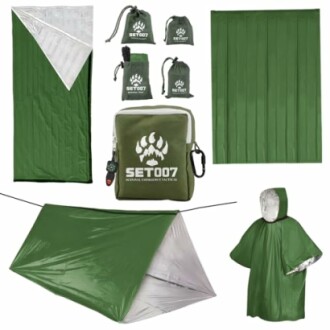
Essential Features of an Effective Emergency Kit
Key Takeaways
- Every emergency kit should include basic survival gear such as food, water, and first aid supplies.
- Look for portable, waterproof items that are easy to store and carry.
- An effective emergency kit should accommodate various emergency scenarios.
- Regularly check and update your emergency kit to ensure all items are in working order.
- Take advantage of tools like the Emergency Kit Analyzer Tool for personalized guidance.
Emergencies can strike at any moment, making it crucial to have an effective emergency kit ready. Whether you're facing a natural disaster, an extended outdoor adventure, or a sudden power outage, your emergency kit must contain the right supplies to keep you safe and prepared. This comprehensive guide will help you understand the must-have features of an effective emergency kit using our Analyzer Tool.
1. Food and Water Supplies
One of the most critical features of an emergency kit is a reliable source of food and water. Emergency food supplies should be non-perishable, lightweight, and nutritionally balanced. For example, consider including:
- Energy bars or protein bars
- Freeze-dried meals
- Dried fruits and nuts
- Canned goods
In addition to food, you should have enough water for at least three days. A good rule of thumb is to store one gallon of water per person per day.
2. First Aid Supplies
A first aid kit is essential for treating injuries that may occur during an emergency. Your first aid kit should include:
- Adhesive bandages of various sizes
- Antiseptic wipes or ointments
- Gauze pads and adhesive tape
- Scissors and tweezers
Make sure to also include any personal medications or critical care items that you or your family members may need.
3. Communication Devices
Staying connected during an emergency is vital. Consider incorporating the following communication devices in your kit:
- Battery-operated or hand-crank radio
- Two-way radios
- Mobile phone with backup battery or solar charger
4. Lighting Solutions
No emergency kit would be complete without some form of lighting solutions. Include:
- Flashlights with extra batteries
- Candles and matches or lighters
- Glow sticks
5. Important Documents and Cash
Keep important documents such as IDs, insurance policies, and medical records in a waterproof bag. Also, store cash in small denominations, as ATMs may not be functional during an emergency.
6. Survival Gear
For outdoor emergencies, survival gear can dramatically increase your chances of staying safe. Here’s a list of essential survival gear items:
- Multi-tool or knife
- Fire starters
- Emergency blankets
- Signaling devices like whistles or mirror
Featured Survival Gear Product
Survival Kit, Emergency Tent with Paracord
This comprehensive survival kit includes a portable emergency tent, thermal mylar poncho, survival blanket, and more, designed for optimal emergency preparedness.
Learn More7. Clothing and Personal Gear
Your emergency kit should also include extra clothing and personal care items:
- Warm clothing including gloves, hats, and thermal wear
- Sturdy shoes or footwear
- Personal hygiene products
8. Shelter Options
In certain scenarios, having shelter options can be a lifesaver. Look for items such as:
- Mylar emergency tents
- Tarps and sleeping bags
- Compact safety blankets
9. Customization for Specific Situations
Remember, every emergency kit should be tailored to your unique situation. Consider factors like:
- Your local climate
- Potential threats in your area (e.g., natural disasters)
- The specific needs of family members (elderly, children, pets)
10. Regular Maintenance and Review
Your emergency kit should not be a stagnant resource. Make it a habit to regularly check your supplies, especially food and medications, and replenish them as necessary.
Conclusion
An effective emergency kit should cover all your bases, ensuring you and your loved ones are prepared no matter the situation. Investing time in understanding these essential features will enable you to create a well-rounded and functional emergency kit. Take advantage of our Emergency Kit Analyzer Tool to evaluate your current kit or any potential additions!
Tips for Beginners
- Start small and gradually build up your emergency kit.
- Research items specific to your typical outdoor activities or your community's risks.
- Involve all family members in creating the kit so everyone knows its location and contents.
Additional Resources
For further reading, check out our in-depth articles on:
